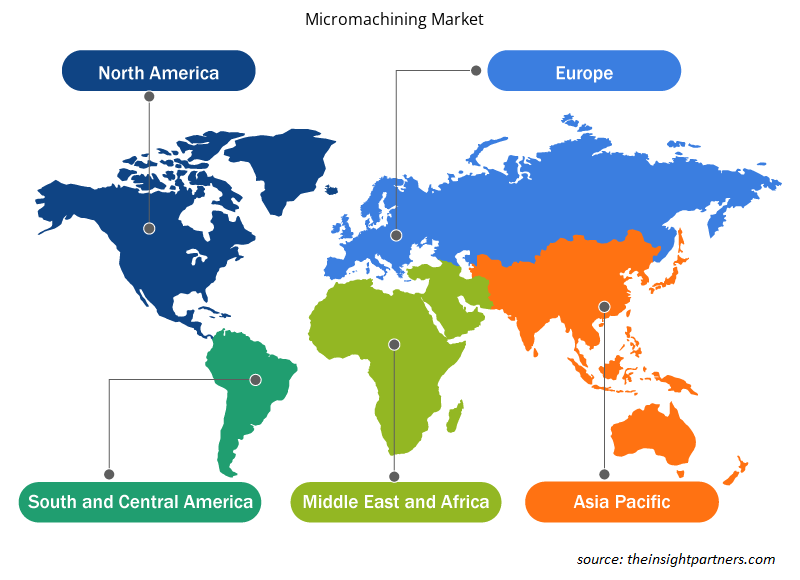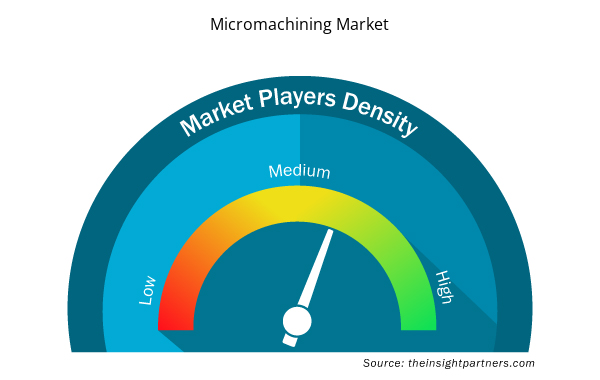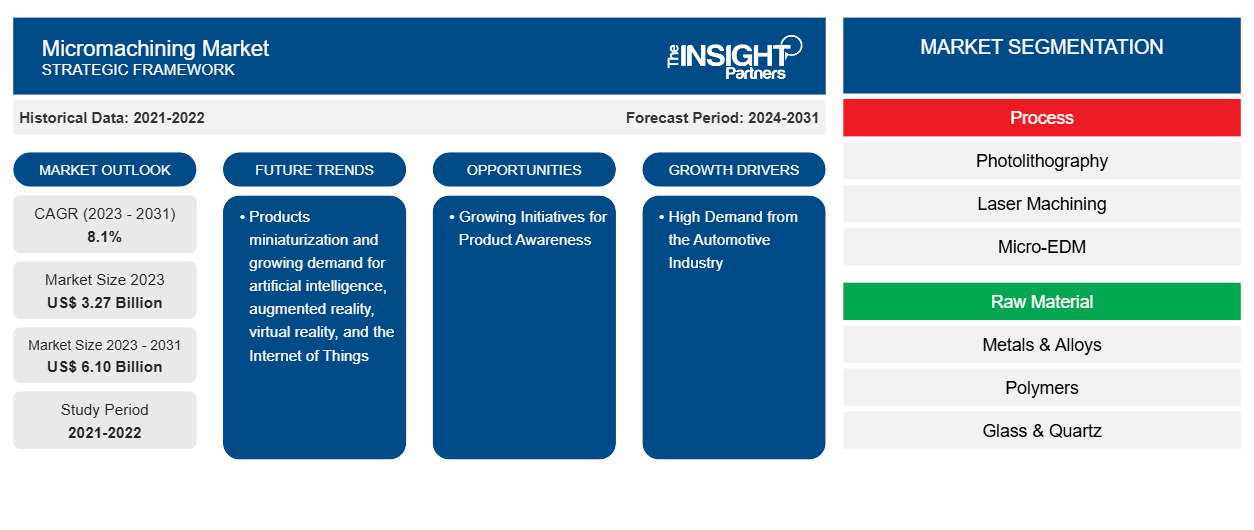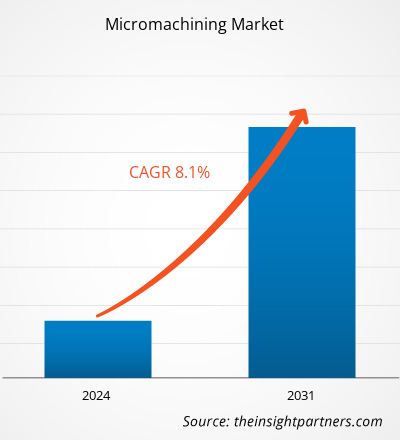マイクロマシニング市場規模は、2023年の32億7,000万米ドルから2031年には61億米ドルに達すると予測されています。市場は2023年から2031年にかけて8.1%のCAGRを記録すると予想されています。製品の小型化と、人工知能、拡張現実、仮想現実、モノのインターネットに対する需要の高まりは、今後もマイクロマシニング市場の主要なトレンドであり続けると思われます。
マイクロマシニング市場分析
マイクロマシニング市場は、自動車業界からの需要の高さと、レーザー加工および電気化学加工の利用増加により、急速に成長しています。市場は、自動車産業の拡大に向けた政府支出の増加と電気自動車の生産増加に牽引されて着実に拡大しています。さらに、製品認知度の向上とセンサー融合技術の開発に向けた取り組みの拡大により、市場の成長に有利な機会が生まれています。
マイクロマシニング市場の概要
マイクロマシニングとは、マイクロメートルスケールで 3D および 2D 構造を作成するプロセスです。技術の進歩以前は、時計の部品は小さな部品と見なされていましたが、その後、マイクロ部品は電子機器や生体医療インプラントを含むさまざまな業界で使用されています。溶接、切断、3D 加工、マイクロミリングなどのマイクロマシニングアプリケーションは、半導体や電子機器、自動車、航空宇宙、医療などの業界で、コンパクトでコスト効率が高く実用的な製品に対する需要の高まりに応じて成長しました。これらの業界の改善により、市場に大きな成長の機会が生まれています。さらに、自動車、民生用電子機器、ヘルスケア、航空宇宙の各業界でマイクロ部品の製造にマイクロマシニングが採用され、市場が成長しています。
要件に合わせてレポートをカスタマイズする
このレポートの一部、国レベルの分析、Excelデータパックなど、あらゆるレポートを無料でカスタマイズできます。また、スタートアップや大学向けのお得なオファーや割引もご利用いただけます。
- このレポートの主要な市場動向を入手してください。この無料サンプルには、市場動向から見積もりや予測に至るまでのデータ分析が含まれます。
マイクロマシニング市場の推進要因と機会
自動車業界からの需要の高さが市場を牽引
マイクロマシニングは、その幅広い用途により、自動車業界でますます人気が高まっています。燃料噴射技術、特に燃料噴射ノズルで使用されています。燃料噴射技術は、車両の燃費を向上させます。燃料噴射ノズルは、EDMプロセスを使用してマイクロマシニングされます。自動車業界でのマイクロマシニングにおけるレーザー技術の使用により、さまざまな車両コンポーネントのシームレスな溶接と接着の必要性が高まっています。さらに、マイクロマシニングは車の燃料消費量の削減にも役立ち、消費者の需要を高め、市場を牽引します。
さらに、消費者の間で電気自動車に対する需要が高まっていることも、予測期間中に市場を押し上げています。マイクロマシニングは、電気電池の製造に広く使用されており、自動車産業を大きく拡大してきました。しかし、予測期間中、拡大する自動車産業と世界中の消費者の間での電気自動車に対する需要の増加が市場を牽引しています。
製品認知度向上に向けた取り組みの拡大 - マイクロマシニング市場におけるチャンス
近年、消費者の意識を高めるイベントが増えており、さまざまな国の政府がマイクロマシニング関連のイベントや会議を開催して、ユーザーの間で意識を高める計画を立てています。たとえば、国際研究会議は、2024 年 6 月 27 日から 28 日にトルコのイスタンブールで国際マイクロマシニング会議 (ICM) を開催する予定です。この会議では、マイクロマシニングのあらゆる側面が取り上げられ、最新のブレークスルー、トレンド、懸念事項、マイクロマシニング分野で直面している実際の問題や実装されたソリューションなど、近い将来に市場の成長が加速するでしょう。
マイクロマシニング市場レポートのセグメンテーション分析
マイクロマシニング市場分析の導出に貢献した主要なセグメントは、プロセス、原材料、およびアプリケーションです。
- プロセスに基づいて、マイクロマシニング市場は、フォトリソグラフィー、レーザー加工、マイクロEDM、マイクロメカニカル加工に分類されます。レーザー加工セグメントは、CO2レーザーマイクロマシニング、IRレーザーマイクロマシニング、グリーンレーザーマイクロマシニング、UVレーザーマイクロマシニングに分類されます。フォトリソグラフィーセグメントは、2023年に大きな市場シェアを占めました。
- 原材料に基づいて、市場は金属と合金、ポリマー、ガラスと石英、セラミックに分類されます。ポリマーセグメントは2023年に大きな市場シェアを占めました。
- 用途別に見ると、マイクロマシニング市場は航空宇宙・防衛、医療、通信、半導体・電子機器、自動車、産業、その他に分類されます。2023年には自動車部門がより大きな市場シェアを占めました。
地域別マイクロマシニング市場シェア分析
マイクロマシニング市場レポートの地理的範囲は、主に北米、アジア太平洋、ヨーロッパ、中東およびアフリカ、南米/中南米の 5 つの地域に分かれています。
収益面では、中国、インド、韓国などの国々に大手自動車部品メーカーが存在するため、アジア太平洋市場がマイクロマシニング市場で最大のシェアを占めています。これらのメーカーは、燃料インジェクター、電気アセンブリ、自動車センサーなどの主要な自動車部品の製造にマイクロマシニングを強く求めています。さらに、マイクロマシニングがもたらすメリットに関する認識の高まりと、鉄道およびエネルギー業界からの需要の高まりが市場を押し上げています。
マイクロマシニング市場の地域別洞察
予測期間を通じてマイクロマシニング市場に影響を与える地域的な傾向と要因は、Insight Partners のアナリストによって徹底的に説明されています。このセクションでは、北米、ヨーロッパ、アジア太平洋、中東およびアフリカ、南米および中米にわたるマイクロマシニング市場のセグメントと地理についても説明します。

- マイクロマシニング市場の地域別データを入手
マイクロマシニング市場レポートの範囲
| レポート属性 | 詳細 |
|---|---|
| 2023年の市場規模 | 32億7千万米ドル |
| 2031年までの市場規模 | 61億ドル |
| 世界のCAGR(2023年~2031年) | 8.1% |
| 履歴データ | 2021-2022 |
| 予測期間 | 2024-2031 |
| 対象セグメント | プロセス別
|
| 対象地域と国 | 北米
|
| 市場リーダーと主要企業プロフィール |
|
マイクロマシニング市場のプレーヤー密度:ビジネスダイナミクスへの影響を理解する
マイクロマシニング市場は、消費者の嗜好の変化、技術の進歩、製品の利点に対する認識の高まりなどの要因により、エンドユーザーの需要が高まり、急速に成長しています。需要が高まるにつれて、企業は提供を拡大し、消費者のニーズを満たすために革新し、新たなトレンドを活用し、市場の成長をさらに促進しています。
市場プレーヤー密度とは、特定の市場または業界内で活動している企業または会社の分布を指します。これは、特定の市場スペースに、その規模または総市場価値と比較して、どれだけの競合相手 (市場プレーヤー) が存在するかを示します。
マイクロマシニング市場で事業を展開している主要企業は次のとおりです。
- 3D-マイクロマックAG
- 4JETマイクロテック株式会社
- IPGフォトニクス株式会社
- KJレーザーマイクロマシニング
- オプテック株式会社
- オックスフォードレーザーズ株式会社
免責事項:上記の企業は、特定の順序でランク付けされていません。

- マイクロマシニング市場のトップキープレーヤーの概要を入手
マイクロマシニング市場のニュースと最近の動向
マイクロマシニング市場は、主要な企業出版物、協会データ、データベースなどの一次調査と二次調査後の定性的および定量的データを収集することによって評価されます。以下は、マイクロマシニング市場の動向と戦略のリストです。
- 2023 年 8 月、Posalux Group は SEMICON Europa 2023 で ULTRASPEED MONO と ULTIMATE DUO の 2 つのマシンを発表しました。ドイツのミュンヘンで 11 月 14 日から 17 日まで開催される Productronica との共催イベントは、機械マイクロ加工技術の最前線に関心を持つ人々にとって記念すべき機会となるでしょう。(出典: Posalux Group、プレスリリース、2023 年)
マイクロマシニング市場レポートの対象範囲と成果物
「マイクロマシニング市場の規模と予測(2021〜2031年)」レポートでは、以下の分野をカバーする市場の詳細な分析を提供しています。
- 対象範囲に含まれるすべての主要市場セグメントの世界、地域、国レベルでの市場規模と予測
- 市場の動向(推進要因、制約、主要な機会など)
- 今後の主な動向
- 詳細なPEST/ポーターの5つの力とSWOT分析
- 主要な市場動向、主要プレーヤー、規制、最近の市場動向を網羅した世界および地域の市場分析
- 市場集中、ヒートマップ分析、主要プレーヤー、最近の動向を網羅した業界の状況と競争分析
- 詳細な企業プロフィール
- 過去2年間の分析、基準年、CAGRによる予測(7年間)
- PEST分析とSWOT分析
- 市場規模価値/数量 - 世界、地域、国
- 業界と競争環境
- Excel データセット



Report Coverage
Revenue forecast, Company Analysis, Industry landscape, Growth factors, and Trends

Segment Covered
This text is related
to segments covered.

Regional Scope
North America, Europe, Asia Pacific, Middle East & Africa, South & Central America

Country Scope
This text is related
to country scope.
よくある質問
The incremental growth expected to be recorded for the global micromachining market during the forecast period is US$ 2.83 billion.
The global micromachining market is expected to reach US$ 6.10 billion by 2031.
The key players holding majority shares in the global micromachining market are 3D-Micromac AG, 4JET Microtech GmbH, IPG Photonics Corporation, KJ Laser Micromachining, and OpTek Ltd.
Products miniaturization and growing demand for artificial intelligence, augmented reality, virtual reality, and the Internet of Things to play a significant role in the global micromachining market in the coming years.
The high demand from the automotive industry and the rising use of laser machining and electrochemical machining are the major factors that propel the global micromachining market.
The global micromachining market was estimated to be US$ 3.27 billion in 2023 and is expected to grow at a CAGR of 8.1% during the forecast period 2023 - 2031.
Trends and growth analysis reports related to Electronics and Semiconductor : READ MORE..
The Insight Partners performs research in 4 major stages: Data Collection & Secondary Research, Primary Research, Data Analysis and Data Triangulation & Final Review.
- Data Collection and Secondary Research:
As a market research and consulting firm operating from a decade, we have published and advised several client across the globe. First step for any study will start with an assessment of currently available data and insights from existing reports. Further, historical and current market information is collected from Investor Presentations, Annual Reports, SEC Filings, etc., and other information related to company’s performance and market positioning are gathered from Paid Databases (Factiva, Hoovers, and Reuters) and various other publications available in public domain.
Several associations trade associates, technical forums, institutes, societies and organization are accessed to gain technical as well as market related insights through their publications such as research papers, blogs and press releases related to the studies are referred to get cues about the market. Further, white papers, journals, magazines, and other news articles published in last 3 years are scrutinized and analyzed to understand the current market trends.
- Primary Research:
The primarily interview analysis comprise of data obtained from industry participants interview and answers to survey questions gathered by in-house primary team.
For primary research, interviews are conducted with industry experts/CEOs/Marketing Managers/VPs/Subject Matter Experts from both demand and supply side to get a 360-degree view of the market. The primary team conducts several interviews based on the complexity of the markets to understand the various market trends and dynamics which makes research more credible and precise.
A typical research interview fulfils the following functions:
- Provides first-hand information on the market size, market trends, growth trends, competitive landscape, and outlook
- Validates and strengthens in-house secondary research findings
- Develops the analysis team’s expertise and market understanding
Primary research involves email interactions and telephone interviews for each market, category, segment, and sub-segment across geographies. The participants who typically take part in such a process include, but are not limited to:
- Industry participants: VPs, business development managers, market intelligence managers and national sales managers
- Outside experts: Valuation experts, research analysts and key opinion leaders specializing in the electronics and semiconductor industry.
Below is the breakup of our primary respondents by company, designation, and region:

Once we receive the confirmation from primary research sources or primary respondents, we finalize the base year market estimation and forecast the data as per the macroeconomic and microeconomic factors assessed during data collection.
- Data Analysis:
Once data is validated through both secondary as well as primary respondents, we finalize the market estimations by hypothesis formulation and factor analysis at regional and country level.
- Macro-Economic Factor Analysis:
We analyse macroeconomic indicators such the gross domestic product (GDP), increase in the demand for goods and services across industries, technological advancement, regional economic growth, governmental policies, the influence of COVID-19, PEST analysis, and other aspects. This analysis aids in setting benchmarks for various nations/regions and approximating market splits. Additionally, the general trend of the aforementioned components aid in determining the market's development possibilities.
- Country Level Data:
Various factors that are especially aligned to the country are taken into account to determine the market size for a certain area and country, including the presence of vendors, such as headquarters and offices, the country's GDP, demand patterns, and industry growth. To comprehend the market dynamics for the nation, a number of growth variables, inhibitors, application areas, and current market trends are researched. The aforementioned elements aid in determining the country's overall market's growth potential.
- Company Profile:
The “Table of Contents” is formulated by listing and analyzing more than 25 - 30 companies operating in the market ecosystem across geographies. However, we profile only 10 companies as a standard practice in our syndicate reports. These 10 companies comprise leading, emerging, and regional players. Nonetheless, our analysis is not restricted to the 10 listed companies, we also analyze other companies present in the market to develop a holistic view and understand the prevailing trends. The “Company Profiles” section in the report covers key facts, business description, products & services, financial information, SWOT analysis, and key developments. The financial information presented is extracted from the annual reports and official documents of the publicly listed companies. Upon collecting the information for the sections of respective companies, we verify them via various primary sources and then compile the data in respective company profiles. The company level information helps us in deriving the base number as well as in forecasting the market size.
- Developing Base Number:
Aggregation of sales statistics (2020-2022) and macro-economic factor, and other secondary and primary research insights are utilized to arrive at base number and related market shares for 2022. The data gaps are identified in this step and relevant market data is analyzed, collected from paid primary interviews or databases. On finalizing the base year market size, forecasts are developed on the basis of macro-economic, industry and market growth factors and company level analysis.
- Data Triangulation and Final Review:
The market findings and base year market size calculations are validated from supply as well as demand side. Demand side validations are based on macro-economic factor analysis and benchmarks for respective regions and countries. In case of supply side validations, revenues of major companies are estimated (in case not available) based on industry benchmark, approximate number of employees, product portfolio, and primary interviews revenues are gathered. Further revenue from target product/service segment is assessed to avoid overshooting of market statistics. In case of heavy deviations between supply and demand side values, all thes steps are repeated to achieve synchronization.
We follow an iterative model, wherein we share our research findings with Subject Matter Experts (SME’s) and Key Opinion Leaders (KOLs) until consensus view of the market is not formulated – this model negates any drastic deviation in the opinions of experts. Only validated and universally acceptable research findings are quoted in our reports.
We have important check points that we use to validate our research findings – which we call – data triangulation, where we validate the information, we generate from secondary sources with primary interviews and then we re-validate with our internal data bases and Subject matter experts. This comprehensive model enables us to deliver high quality, reliable data in shortest possible time.


 このレポートの無料サンプルを入手する
このレポートの無料サンプルを入手する